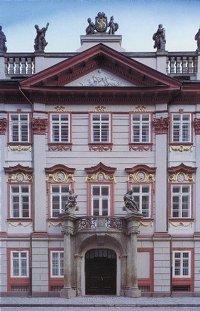Sweerts-Sporck Palace

Yesterday
The palace, situated in the centre of Prague on Hybernská Street, is thought to be the last Baroque building to have been erected in the city. It was developed on the site of former medieval Gothic houses acquired in 1694 by Count Karl Joachim of Breda, who built a splendid Baroque palace there. The palace soon passed into the hands of Count Franz Anton Sporck (1622–1738), an outstanding personality of the Czech Baroque era. The palace made its mark on the cultural history of Prague as a theatre where Italian opera companies performed in the first half of the 18th century.
During the period from the 1760s to 1803, the palace was extensively rebuilt by its owner, Johann Franz Christian Sweerts-Sporck, the grandson of Count Sporck. From 1783 onwards, the work was directed by Anton Haffenecker, the architect also responsible for the rebuilding of Prague Castle. He designed the monumental facade with its attic balustrade, decorated with allegoric sculptures from the workshop of Franz Michael Platzer. The work was continued by another Prague Baroque architect and builder, Ignazio Palliardi.
After 1803, the palace frequently changed hands, and in 1844, it was acquired by the state. The state institutions that occupied the building in the years to follow had made various alterations to the structure, destroying its original character and appearance.
In 1963, a substantial part of the building was occupied by the newly established Department of Translation and Interpreting (later, the Institute of Translation Studies). When the department was incorporated into the Faculty of Arts in the mid-1970s, the palace, by then in a bad state of repair, was acquired by Charles University.
Today
During the academic year 1998/1999, the university renovated the building and restored the Sweerts-Sporck Palace to its original architectural state and splendour. The newly renovated building was officially opened on 27 October 1999. It houses the Institute of Translation Studies, the Centre of Ibero-American Studies and the Centre of Comparative Studies.
As a part of the restoration process, the teaching, study and library facilities of the institute were expanded and improved, including rooms equipped with up-to-date technology suitable for conferences and symposia.
Special facilities have been installed for the teaching of interpreting. The interpreting room is equipped with state-of-the-art technology donated by the TAIEX Office of the European Commission. Undergraduate students of interpreting and postgraduate students attending the Euromasters Course in Conference Interpreting benefit from the use of these facilities.
A specialized studio equipped for courses in subtitling and on-line translation teaching is available, and in the attic space under the restored Baroque roof, there is a computer lab with seating for 75 students. All computers in the building are connected to the university’s network by fibre-optic cables. The basement rooms, believed to have been originally a Masonic lodge, have been converted into a modern library repository.